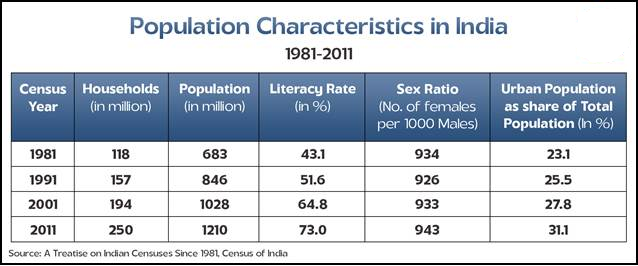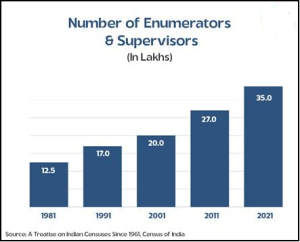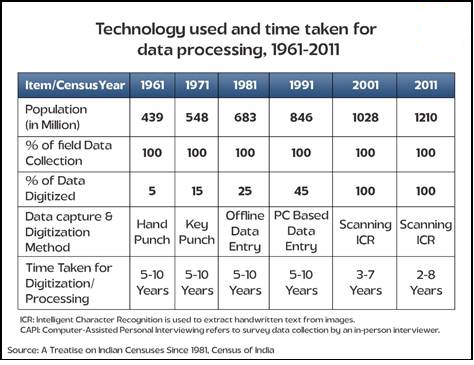Key Observations from 1981-2011 Census


Census 2011: Major Findings and Innovations
1. Multilingual Operations: The Census Schedules were surveyed in 16 different languages to accommodate India’s linguistic diversity.
2. Massive Printing Requirements: The exercise required printing of approximately 5.4 million instruction manuals and 340 million Census Schedules to support the nationwide operation.
3. Extensive Human Resources: A workforce of 2.7 million enumerators and supervisors was engaged to carry out the census-taking activities across the country.
4. Geographic Coverage: The census operations spanned across:
35 States and Union Territories
640 districts
5,924 sub-districts
7,933 towns
6.41 lakh villages
5. Unique Integration: Census 2011 featured a distinctive approach where Schedules for preparation of the National Population Register (NPR) were canvassed simultaneously with the Houselisting Schedules, making it a comprehensive demographic exercise.
6. Logistical Achievement: The scale and complexity of coordinating such a massive operation across India’s diverse geographical and linguistic landscape demonstrated the organisational capabilities of the census machinery.
Key demographic findings from Census 2011
1. Total population: 1.21 Billion with males comprising 623.2 million and females 587.6 million, as of March 1, 2011.
2. Population growth: 182 million increase during the decade 2001-2011.
3. The child sex ratio was 918 females per thousand males in 2011.
4. The population density of India in 2011 was 382 per sq km, with a decadal growth of 17.7 per cent.
5. The literacy rate in the country is 73.0 per cent, 80.9 for males and 64.6 for females. Kerala retained its position by being on top with a 94.0 per cent literacy rate, closely followed by Lakshadweep (91.8 per cent) and Mizoram (91.3 per cent).

SECC 2011: Socio-Economic and Caste Dimensions
1. Caste Enumeration (After 80+ Years)
1. For the first time since independence, all castes (not just SCs/STs) will be enumerated.
2. Previous censuses post-1951 excluded caste enumeration, barring SC/ST data.
3. This move responds to calls for social justice, accurate targeting, and inclusive policies.
4. Integrating caste enumeration into the main census (rather than a standalone caste survey) avoids duplication and minimises politicisation.
2. Digital Transformation
| Feature |
Description |
| Mobile App-based Data Collection |
Real-time, paperless enumeration |
| Online Self-enumeration |
Citizens can register and submit details via the official portal |
| Census Monitoring Portal |
Multilingual support and real-time data tracking |
| Code Directory |
Standardises responses for consistent data processing |
| In-built Validation Checks |
Ensures accuracy and reduces human error |
| Enumerator Training |
Training for over 35 lakh field staff |
3. Operational Framework
The reference date for the census shall be 00.00 hours (12 AM midnight) of the 1st day of March, 2027 except for the Union Territory of Ladakh and snow-bound areas of the Union Territory of J&K, and the states of Himachal Pradesh and Uttarakhand.
For the Union Territory of Ladakh and snow-bound areas of the Union Territory of J&K, and the states of Himachal Pradesh and Uttarakhand, the reference date shall be 00:00 hours (12 AM midnight) of the 1st day of October, 2026.
Conclusion
As World Population Day 2025 calls for a hopeful and fair world where young people shape their families and futures, India responds with the most ambitious and transformative census in its history. Census 2027, through its digital-first approach and inclusive vision, is set to become a cornerstone of India’s development strategy in the Digital Decade. It stands not just as a statistical exercise but as a powerful tool for equity, empowerment, and nation-building, ensuring that every voice in India’s 1.4+ billion-strong population is counted and heard in shaping the policies of Tomorrow.
Prelims Questions








No Comments